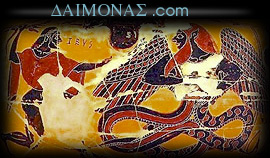OPHIOLATRY
The Snake & the Spiral: their origins in Europe.
This prologue has been added 30/1/2010 (and modified at a later date).
Note: someone has illegally uploaded this page to the pirate site "scribd.com".
This is without my permission. No emailed request was made to reproduce this page by these pernicious Americans. My copy right to my intelletual property is automatic under Australian law. My copy right is asserted on the top and the bottom of this page - and all of the other pages on this site. I can be emailed, via this site, to gain copyright permission. No such permission was ever sought or ever granted. Scribd.com, the burden of proof is yours; you have to show that you gained copy right permission.
The screenshot below shows the page as it appears on scribd.com's site. The screenshot clearly shows that the uploaded file has the url "http://www.daimonas.com/pages/snake-worship.html" (the address of this page) appearing at the top, and shows that the author is Demetrios Vakras.

According to scribd.com, "iPaper [the format in which they pirate the works of others] was developed by Scribd to democratize publishing for all." This "democratizing" [sic] however, is nothing different from the Stalinist redistribution of wealth. Scribd.com is indulging in a Stalinist collectivisation of the intellectual property of others.
The page in question was removed by "scrbd.com" on 2/2/2010. However, the uploader's profile still exists, and he/she writes (on 3/2/2010) that they will be replacing all of the removed content.
The word "sample" now apears on the images. For that you can thank the idiot who hides behind the pseudonym "sonden" and "sonden_2" who illegally uploaded my content on to "scribd.com")
Now, to the original essay:
Among the earliest representations of the cosmos are the "Vinca" bowls which represent the heavens in the form of an ecliptic snake which coils its way to the polar axis. These bowls, as well as coiled clay snakes, date to the end of the sixth millennium BC.
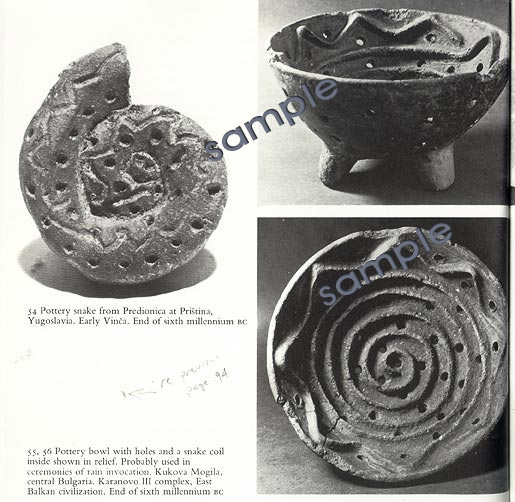
|
The Vinca Bowl and clay coiled snake dating to the end of the 6th millennium BC, p.95 The Goddesses and Gods of Old Europe : Myths and Cult Images
By: Marija Gimbutas Isbn 0520046552
Amazon link
|
Gimbutas writes of this bowl that it was "probably used in rain ceremonies of rain invocation" (p.95, Goddesses & Gods of Old Europe), in her attempt to account for the holes. However, once realised that this bowl actually represent the heavens, it becomes immediately evident that the holes represent the stars/constellations. This is the night sky. Essentially the zig-zagging aspect of the serpent at the bowl rim represents the ecliptic with the snake continuing to spiral around the bowl where it ends around the "void", what the Greeks called the "chasm" (meaning "where all is lost"), which so mesmerised the Pytho (feminine for python), the otherwise known Oracle, the protectress and seeress at Delphi. The so-called "Vinca" culture included northern Greece and Thessaly. It is not unsurprising therefore to find that the earth-encircling serpent survived well into classical times. Though the Greeks fragmented the serpent into the zig-zagging Hydra (the feminine for "water") at the ecliptic, and Draco who spirals around the "chasm", the motifs are unmistakably the same.
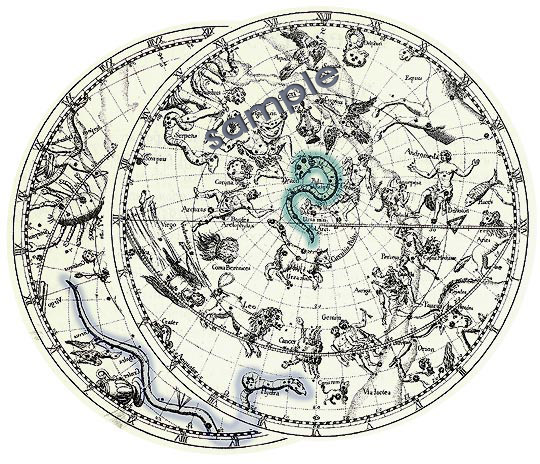
18th Century (AD) star chart showing the constellations of Draco and Hydra. Draco is shaded green. Hydra is shaded blue/lilac.
p. 213 Star Myths: "The [star charts] are reproduced with some simplifications from Erastothenis Catasterismi cum Interpretatione Latina et Commentario, edited by J.C. Schaubach (Gottingen, 1975)." Condos.
|
The star charts are reproduced on pp. 214-215 Star Myths by Theony Condos. Isbn 1890482935 (Amazon link).
Condos gets so much so wrong. To cite one such instance:
"The origin of [Draco] is apparently Phoenician. There is no evidence of a Babylonian serpent constellation." Star Myths p.103.
Though Condos should be aware of Mycenaean (c.1550-1150 BC) snake-cults, and that the origins of the cosmic snake cult lies in the heart of the Balkans she prefers to attribute constellations to the Near East.
The Phoenicians to whom she attributes the snake constellation only became a maritime phenomenon after the invasions of the "Sea People" who settled in the Levant en masse at around 1150-1100 BC. These "Sea People" have proven to be largely of Mycenaean/Aegean origin. (Some have been identified as Sardinian). The "Phoenicians" as a sea-faring phenomenon did not commence until 1000-900BC, after the sea-faring "Sea People" settled in the area that came to be known as "Phoenicia".
It is evident then that these Aegean people became "Semiticised", taking up the language of the people among whom they settled. Recent archaeology of inscriptions by the Philistines written in Semitic at Ekron pay homage to "Ge", the Greek mother-earth goddess, and "Pytho", the seeress at Delphi (the "Oracle").
(The adoption of the language of the local population by foreign conquerors is not a unique occurrence. To use a better known though later example: Vikings landed and settled in Normandy. They abandoned their own language and adopted French. They invaded England in 1066 and imposed their adopted French language on the English.)
The appearance of a Balkan serpent constellation in the Levant is attributable to the arrival of a foreign element into the Levant. That element was Aegean: Greek.
|
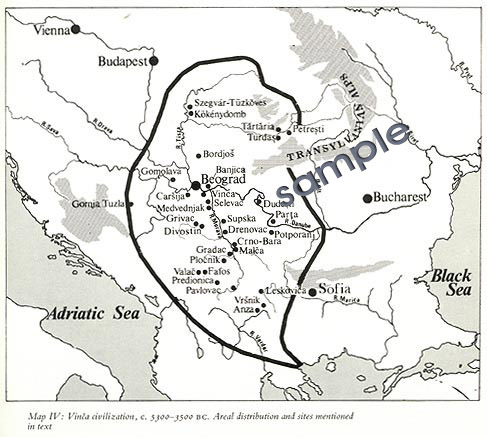
|
Map of the Vinca "Civilization" p.23 The Goddesses and Gods of Old Europe : Myths and Cult Images
By: Marija Gimbutas. |
The snake finds continuous representation in the Balkans since its appearance in the 6th millennium BC (and this is not limited to the images reproduced on this page).
Snake veneration in Crete, for example, is seen in the form of the snake goddess found at Knossos dating to the 17th century BC, as well as, for example, earrings, such as the one showing a double-headed, earth encircling serpent. This is the Hydra-cum-Ophion-cum-MidgardWorm (Midgard Serpent).
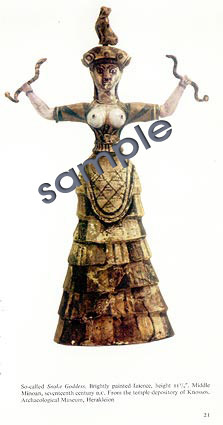
Above; The "snake goddess" of Krete.
Right: Earring from the Aigina Treasure, from p.195 The Arts in Prehistoric Greece by Sinclair Hood Isbn: 0140561420
Amazon link
|
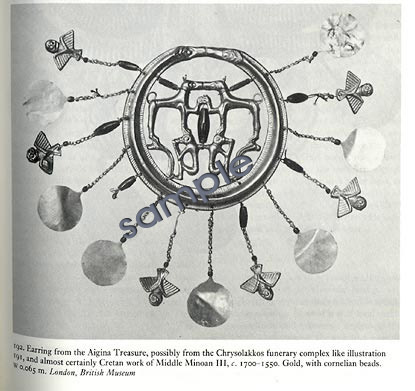
The earring above, found in the Chrysolakkos funerary complex on Krete, has been dated to between c. 1700-1550 BC. Although attributed to the Minoans, the author feels that it is instead attributable to Theran craftsmanship. It represents the cosmos with a double-headed earth-encircling serpent surrounded by seven celestial bodies (sun, moon, and 5 planets visible to the unaided eye) which are "mirrored" by their bird avatars. Enclosed are 2 Aegean spiral-tailed dogs which in turn stand on monkeys.
There is some evidence for these monkeys in later Classical Greek mythology. But this information survives only in later commentary, such as the Suidas which includes the curious tale of two mischievous monkeys, the Kerkopes (Cercopes) who were turned to stone when they attempted to deceive ZEYS.
(As it is the author's contention that ideas that coalesced in the Aegean eventually found their way to India, it is probably in Hindu myths involving the monkey that additional aspects of these monkeys might be found.)
|
|
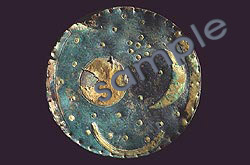
The above representation is of what has come to be known as the "Nebra Star Disc" found in Germany. This disc represents the heavens around which courses an encircling river. A boat is represented sailing along the rim of the disc.
Addenda 23 Feb 2008
Andis Kaulins proposes an alternative interpretation. He proposes a "revised interpretation of the Nebra Sky Disk [which] concludes that the Nebra Sky Disk records the solar eclipse of April 16, 1699 BC for posterity. That solar eclipse took place next to the Pleiades at sunrise near the point of the Vernal Equinox, together with a near conjunction of the planets Mercury, Mars and Venus as "bridesmaids" for the "wedding" of the Sun and the Moon - a total solar eclipse - a rare and spectacular event for the ancients. This interpretation allows not only for a partial explanation of the Nebra Sky Disk but in fact explains all of the elements found on the disk in an integrated astronomical context." (Kaulins is the author of Stars, Stones and Scholars: The Decipherment of the Megaliths As an Ancient Survey of the Earth by Astronomy. His conclusion, and the means by which it was arrived at, can be found in the following pdf: http://www.megaliths.net/nebraskydisk.pdf
My only objection to his proposal is that he dismisses possible Mycenaean/classical Greek aspects, on the grounds that they are, as he claims, first attested to one thousand years after the date of the Nebra disc. However, he accepts "Baltic folk songs known as the Latvian Dainas [and] (Lithuanian Dainos)", for which there is no independent evidence until around 100 years ago, as being perfectly reasonable; that is, he considers an interpretation which includes tales 3,500 years after the disc was made to be far more valid.
|
Featured in a BBC documentary (BBC link) the documentary makers claimed that the boat which sails around the encircling stream is an "Egyptian sunboat." Unfortunately for the documentary makers, their supposition is entirely wrong. The Egyptian sun-boat sailed along the river in the sky: what we now call the "Milky Way". The Egyptians believed that Egypt was a reflection of the heavens on earth and that the Nile was reflected in the "river of the sky". This is the same river that the Greeks called the "River Styx", (clearly articulated and explained by de Santillana & von Dechend in their book Hamlet's Mill), the river in the sky which fed the river Okeanos which rimmed the earth and divided earth from heaven (as described by Hesiod).
Clearly, the Nebra Star Disc shows the same idea as the Greek "earth-encircling Okeanos" (earth-encircling Ocean), and not the Egyptian river-in-the-sky.
Dating to 1600 BC it is contemporary to the Minoan snake goddess, and predates by 50 years the shaft graves of Mycenae. The Nebra Star Disc is also contemporary with the Theran representation of the cosmos which features an earth-encircling serpent. It is not an accident that both Greek and Norse mythologies shared an idea of an earth encircling ocean and an accompanying water serpent (Hydra for the Greeks, the Midgard Serpent for the Norse). The Nebra Star Disc shows that even by the early bronze age Europe had, despite many differences, a shared view of the cosmos, one entirely different from that of either Egypt or the Near East.
[Additionally, the documantary makers and other commentators have inferred what they claim is the "star-cluster" between the "sun" and "moon" to be the Pleidaes constellation. This too is probably wrong. This "cluster" corresponds to later representations of the planet Venus, in which Venus is represented in the same manner to show the rays of her "radiance".]
|
The serpent persists through the Mycenaean period, the 16-12th centuries BC.
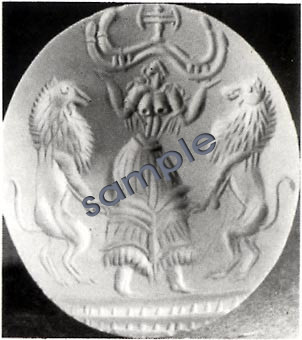
In this Mycenaean gem the goddess who controls the moon, which is represented by the double-axe, controls the serpents of the sky.
It dates to c.1500BC.
The pole of the double-axe represents the "pole" from earth to the polar axis: the "trunk" of the world tree. The forms of the twin double-headed snake, and the central double-axe take the form of the later Greek trident, symbol of Zeus' thunder-weapon.
Note: The 2 crescent moons form outlines which form the complete circle of the full-moon, symbolising the Indo-European division of the phases of the moon into 3: 3x3x3. It should be noted that the "Semitic" tradition divided the phases of the moon into 4x7.
|
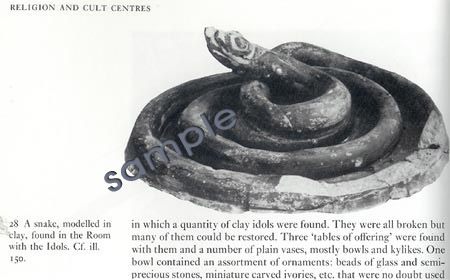
Above: One of the 17 coiled snakes found in the so-called "room with the idols" in Mycenae. It dates to before the 13th century BC. Illustration from The Mycenaeans by William Taylour Isbn: 0500275866
Amazon Link
Left: Illustration from p.43 Art of Crete, Mycenae, and Greece by
German Hafner. Isbn 0810980215.
Amazon Link
|
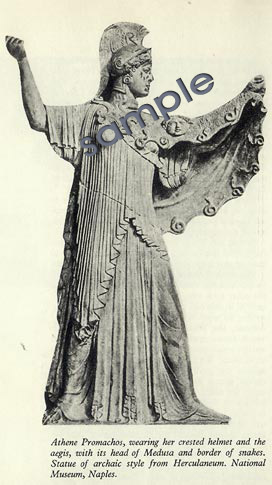
|
Image from p.32, Greek Mythology, by Felix Guirand, translation by Delano Ames. First Published 1935
Athena is mentioned in both in Minoan Linear A, and in the Greek Mycenaean Linear B scripts. She survives into, and is the Matron goddess of all the Greek peoples. She is associated with dominion over the forces of the underworld. It is possibly Athena who is represented in the Kretan snake-goddess figure and in the Mycenaean gem.
Here she wears her aegis with its border of writhing snakes.
[Note, though it is supposed that ZEYS was the "patron" god of the Greeks, this supposition is wrong. ZEYS, who was nearly always referred to as DIOS, was the universal God of all people who might be known by different names to different people. Instead the god of the Greeks was the blue-eyed goddess Athena.]
|
The representation of the snake in European art however is not limited in its earliest expression to the Vinca culture, or to the Balkans. Snake motifs are found everywhere in Upper Paleothithic European art.
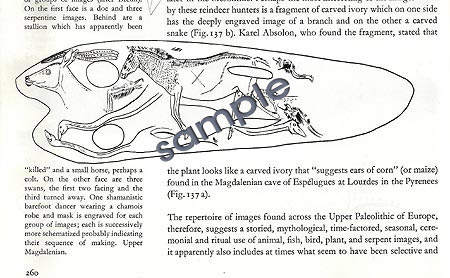
Image from p. 260,
The Roots of Civilization: The Cognitive Beginnings of Man's First Art, Symbol and Notation
by Alexander Marshack ISBN: 1559210419..
(Amazon link).
|
As Marshack is at pains to show, the rendition of animals suggests that they are "time factored" and seasonal motifs. The importance of the snake is that it is a symbol of fertility.
Contrary to Freud, the association of the snake with fertility had nothing to do with any association with the penis. Two phenomena manifested themselves every spring: a barren snow-covered and frozen (mother) Earth would erupt with life. Out of her, living things, trees, grew & out of her crawled the snakes, both absent in winter. (The snake's association with fertility is not as Gimbutas has it that they "regenerate", leaving behind their old skin, though that probably forms a small part). Their additional relevance was, that though they were an indication of rebirth and fertility, their venom meant that they were also arbiters of death.
|
In this motif (one among very many others) snakes entwine themselves around representations of, among other animals, the horse. These representations of snakes predate those of the Vinca snakes from 5 to 20 millennia. The pedigree of the snake in Europe is incredibly old.
The association of the snake with fertility is predicated on the physiology of all snakes. Being ectotherms their temperature is is dependent on external sources. In Europe, snakes withdraw into underground retreats, hibernacula, in the colder months and enter into a period of hibernation for the duration of winter and so are entirely absent. This however is not necessary for snakes in the Near East. Indeed in hot climates, such as deserts, snakes seek protection from the sun during the hottest part of the day and in extreme cases withdraw underground for up to several weeks in a process known as aestivation. The association of snakes with fertility is a European association, made because snakes erupt out of earth at the same time that plants and crops flower; this association of the snake with fertility cannot be made in the Near East. [the information in this section on snakes pp.95-97, Snakes of the World by Chris Mattison. Isbn: 0713714638]
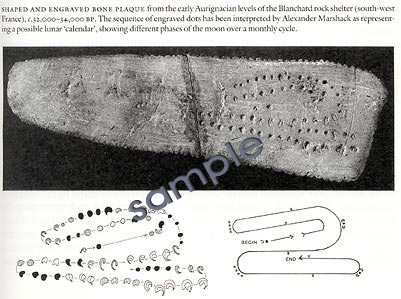
Image from p. 71,
Prehistoric Europe an illustrated history
edited by barry cunliffe ISBN: 0192880632
(Amazon link).
The original image appears in Marshack's book, p.45.
|
This engraved bone dates to c.32000-34000 BC. Alexander Marshack argues that it is a calendar recording the moon's monthly cycle.
A complete explanation which includes lunar nodes calculated to see whether the patterns on the bone conform to the lunar cycle is given by Marshack in his book, pp. 44-50.
|
The evidence of the veneration of snakes in Europe is also accompanied with evidence of the observation, and a concomitant committing of these observations to a permanent record, of the movement of celestial objects. In the above instance it is the phases of the moon. It is no coincidence that the passage of the moon is serpentine.
HOW THEN DID THE SNAKE FIND ITS WAY INTO THE NEAR EAST?
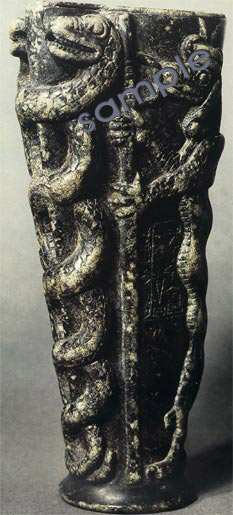
Lagash vase, "the dragon mushussu stone vase" dates to c. 2100BC.
Image source: The Art of the Ancient Near East
by Pierre Amiet, Naomi Noble Richard
ISBN: 0810906384
(Amazon link).
"In the Louvre, there is a famous green steatite vase carved for king Gudea of Lagash (dated variously 2200& 2025 BCE),
dedicated by its inscription to Ningizzida, "Lord of the Tree of Truth" which bears a relief of serpents twined round a staff"
( http://www.reference.com/browse/wiki/Serpent )
|
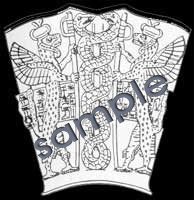
The drawing above is from the internet and shows the image of the vase "rolled out".
A brief digression with regards to the above Lagash vase. Though the guardian beasts are certainly not griffins, they are griffins according to the Wikipedia! Since pages on the Wikipedia are constantly edited, I took a screenshot of the Wikipedia page which makes this claim. It can be found here (near the bottom of the page) The Griffin
|
|
There is a push to attribute the origin of the snake to the Near East. One author, ML West has indeed attributed virtually the entire corpus of Greek mythology and the Greek intellectual achievement to the Near East.
Early Greek Philosophy and the Orient (Oxford Scholarly Classics) by M. L. West. ISBN: 0198142897
Amazon link
|
A Christiano-Judaic desire to place the fulcrum of civilization in the region of Ur, the region where-in the Christiano-Judaic holy book posits as being where "god revealed himself to humanity" (Abraham) has hijacked the intelligentsia *(refer box below). Others are guided by a zealous mission to "correct" "Eurocentricity".
* An example from the internet of the Christiano-Judaic world view:
"the textbook Ancient Literature, Ancient Chronicles [ www.puritans.net ] is especially prepared for courses taught by Westminster Covenant Academy. It is our conviction that the Bible of the Old and New Testaments is the foundation of all true knowledge." |
The above Lagash vase certainly attests to a pair of serpents entwined around a pole, who are in turn guarded by a pair of winged, snake-bodied quadrupeds with taloned lower limbs and whose snake-heads are horned (a "mushussu dragon"). This, for the Christiano-Judaic ideologues, demonstrates emphatically, a pole - which could be the tree of knowledge - protected by the snake, as it is in the story told in their holy book. There are several problems with this. Four serious objections to a mesopotamian origin for the motif of this vase of Lagash can be raised:
OBJECTION 1-The Vinca representations of the spiral snake which coils around the pole predate this vase by 3000 years. This vase has no precedent in Mesopotamia. Indeed, the only context into which it can be fitted is either the Elamites, or the snake-worshipping-Gutti, a people in the mountains to the north of Mesopotamia who conquered Mesopotamia toward the end of the 3rd millennium BC (c.2200BC) and who were despised by the Mesopotamians. The Guti were eventually expelled and destroyed and their presence in Mesopotamia all but totally erased.
The GUTI
The dynasty of the Guti lasted from between c.2200 - 2116 BC. "The Guti kings reigned in obscurity." p.595, Amiet, The Art of the Ancient Near East Isbn: 0810906384.
The Guti had conquered Babylon and deposed the Babylonian dynasty of Agade.
"About the Guti who overthrew the Akkadian empire and ruled over Mesopotamia for almost a hundred years we know next to nothing. The Sumerian King List gives the 'hordes of Gutium' twenty-one kings...in about 2120 B. C., Utuhegal, ensi of Uruk, mustered an army and rose against 'the stinging serpent of the hills'." my italics, p.155 Ancient Iraq, Georges Roux. Isbn 0140208283 (Amazon link)
During the period of Guti rule, and while surrounded by the Guti, Lagash was able to gain some independence. A product of what is claimed to be the Lagash "renaissance" of Sumerian civilization is this serpent vase, on which serpents, previously absent from mesopotamian art, are represented......
GIGLAMESH
How does Gilgamesh fit?
There exists a desire in academia, particularly scholars whose speciality are the civilizations of the Near East, to demonstrate that their interests are not peripheral to the course taken by human civilization, but central to it. Although Gilgamesh has the identical historicity as Herakles, authors like Dalley write, without embarrassment , that though "there is no evidence that any of the Gilgamesh stories were written down before about 2150 BC" and that "[though] precise dates cannot be given for the lifetime of Gilgamesh, [his "lifespan" is] generally agreed to be between 2800 and 2500 BC." pp. 41 & 40 respectively, Myths from Mesopotamia. Stephanie Dalley Isbn 0192835890 (Amazon link)
Another translator of the Gilgamesh stories, Andrew George, includes for our benefit in his The Epic of Gilgamesh a "time chart" which shows Gilgamesh as having actually lived at c.2800 BC, and that he was king of Uruk!
There are a number of problems associated with this which cannot be reconciled :
a/ there is no mention of Gilgamesh on any inscription at all before 2150BC;
b/ there is no archaeological proof whatever that Gilgamesh ever existed;
c/ the King Lists which include Gilgamesh and from which is inferred the kingship of Gilgamesh is as confused as the family line of the Herakleide (those born to Herakles), and the biblical genealogies that were used to calculate that the Jewish YHWH created the world at about 5000BC;
d/ the "King List" itself is an artificial construct created by Th. Jacobsen in 1939. It was "compiled from about fifteen different texts" (Roux, Ancient Iraq, p. 109). This reconstructed king list ends at the 18th century BC. It is evident therefore that the approximate date at which these various lists were compiled & in which the past, and hence the kings of that past was reconstructed, dates only as far back as the 18th century BC; that is, the kings lists end at the 18th century BC because that is when they were compiled (the compilers of these lists worked backward from the date they made their compilation);
e/ in the earliest accounts that do mention Gilgamesh like those of king Shulgi, "who ruled Ur from c.2150-2103 BC... [it is] claimed that...Gilgamesh was [Shulgi's] brother." Dalley Myths from Mesopotamia p.42. That is, Gilgamesh does appear as an historical figure, but is peripheral to the subject of the myths in which his name appears; and more importantly, on face value, he actually lived in the 22nd century BC and no earlier (if it is accepted that he lived at all).
Though George's "time chart" lists the earliest written poem of Gilgamesh as dating to the 21st century BC, the earliest version that exists and which he translates dates to the 18th Century BC, no earlier. The date for this composition conforms to Stephanie Dalley's dating the earliest poems to the 18 century BC. Both the Old Babylonian Version (translated by Dalley) , and the Sumerian Version (translated by George) date only as far back as the 18th century BC.
The dating of Gilgamesh and the sleight-of-hand involved in the scholarship surrounding Gilgamesh might, at this stage, seem to be a considerable digression from the discussion of the snake. However, it is the author's contention that the Gilgamesh tale only dates to the period following the rule of the "stinging serpent of the hills", the Guti , that it is related to their expulsion, and that in the Gilgamesh tales there might be found a reflection of Guti beliefs and cosmology.
There are distinct and irreconcilable differences between the various versions of the Gilgamesh tales. The Old Babylonian Version (dated to c 1750BC) is substantially different from its Sumerian contemporary (of the same period), and both of these are as different from one another as they are to the Standard Babylonian Version which was written onethousand years later.
As Dalley acknowledges (p.43 Myths from Mesopotamia) some Gilgamesh tales are variously set in the Zagros mountains (Iran) whilst others are set in the forests of Syria or Lebanon. It is clear however that the tale of Gilgamesh in all versions is set in the mountains, and not the mesopotamian river-plains, precisely the location of the Guti & of the Elamites, both serpent-worshipping regions.
The OBV and Sumerian rendition of the tale both share a related version of the subjugation of Humbaba (alternately, Huwawa) in which one version has it that Humbaba is subdued, another that he is killed. However, one Sumerian version alone recounts the "solitary tree of the Euphrates" and how it came to be occupied by a demon-woman and snakes. The 18th century BC Sumerian: "Bilgames [Gilgamesh] in the Netherworld" (as translated by George) is thus of considerable interest:
"At that time there was a solitary tree, a willow.... in its base a Snake-that-Knows-no-Charm had made its nest, in its branches a Thunderbird had hatched its brood, in its trunk a Demon-Maiden had built her home... Bilgames [Gilgamesh, brother in this version of the goddess Inanna], took up in his hand [his bronze axe]. In its base the Snake-that-Knows-no-Charm he smote, in its branches the Thunderbird gathered up its brood and went into the mountains, in its trunk the Demon-Maiden abandoned her home and fled to the wastelands. As for the tree, he tore it out at the roots and snapped off its branches. The sons of the city who had come with him lopped off its branches..." lines 114-146, pp.182-183 The Epic of Gilgamesh, by Andrew George Isbn 0140449191 (Amazon link)
A comparison of the Sumerian version of Gilgamesh with the "Standard" Babylonian version written around 1300 years later is instructive. The oldest SBV Gilgamesh tablets are those of Assurbanipal's library at Nineveh (George, introduction, p.xxvii) which thus date only to c.668BC at the earliest. This version of Gilgamesh was therefore written nearly 100 years after Homer's Iliad and Odyssey had been put into writing. The SBV version recounts what appears to be a diferent account with vaguely related, but very different motifs to those that appear in the Sumerian account, all of which are entirely absent in the OBV Gilgamesh:
"Let me reveal a closely guarded matter Gilgamesh, And let me tell you the secret of the gods. There is a plant whose root is like a camel-thorn,... If you yourself can win that plant, you will find rejuvenation... [Gilgamesh] tied heavy stones to his feet. They dragged him down into the Apsu, and he saw the plant. He took the plant himself: it spiked his hands. He cut the heavy stones from his feet. The sea threw him up on to its shore [with the plant]... With it a man may win the breath of life.... I shall take it back to Uruk... At twenty leagues they ate their ration. At thirty leagues they stopped for the night. Gilgamesh saw a pool whose water was cool, and went down into the water and washed. A snake smelt the fragrance of the plant. It came up silently and carried off the plant. As it took it away, it shed its scaly skin." section vi, Tablet XI, SBV Gilgamesh c.670-200 BC, pp.118-119 Myths from Mesopotamia translated by Stephanie Dalley.
In the SBV Gilgamesh, the significance of the tree, and the snake is recast and an association is made with the sacred water that the serpent guards, though the Babylonians never seem to have quite understood an idea that was clearly alien to their own ideas of the cosmos.
[A]
|
Indeed, if either the Sumerian or "standard" Babylonian versions of the tale are to make any sense at all it is only when considering a culture foreign to mesopotamia: that of the Indo-European Greeks.
The Oracle (priestess) at Delphi (whose history is known to be older than the SBV Gilgamesh reference to the "tree of rejuvination"), as one example, was the Pytho, (which as pointed out earlier is the feminine form of "python"). She represented the forces of Ge (Gaia: earth, whose offspring were serpentine). The Oracle at Delphi was set at the "omphalos" (navel) of the world. Stretching from the world-navel to the "chasm", the void around which rotated the circumpolar stars, was the "trunk" of the "world tree". At the head of the tree was the eagle, the symbolic bird of Dios "thundering Zeus" as the Greeks referred to him (which is consistent with the Norse view of the universe with Yggdrasil, the world tree, at the centre of the universe which was gnawed at its root by the serpent Nidhogg, with the eagle, bird of the thunder-god Thor at its summit). Indeed, the Greek word for "sibling" is instructive. The word used in Greek is "adelphia" (from which "philadelphia" is derived) and it essentially implies the connection of offspring to the same mother, as is Delphi, to its source; this is, in essence, the umbilicus which connects Earth's navel to the heavens.
As has been shown in the earlier portion of this essay snake motifs representing snakes coiled around the pole on which the heavens rotate were prolific in the Balkans for 3 millennia prior to either the Lagash vase or the Sumerian version of the Gilgamesh tale, and that their representation continued though the Minoan and Mycenaean period and into the Classical period of Greek civilization. According to Dalley's glossary (p.319), Demons, "asakku" are illness and misfortune personified; evil. And, according to the Sumerian version, the holy world tree was possessed by evil, demons, an affliction in the form of the serpent, the demon maiden, and thunderbird (eagle). These "demons" were expunged by Gilgamesh. The Gilgamesh myth is recounting in mythological form one of two occurrences:
1/ an idea that sacred mesopotamia had been hijacked by foreign dieties/beliefs, and that these usurpers were expunged by a human leader named Gilgamesh who came to be diefied by later generations;
2/ or a myth in which a divine (though not actual) Gilgamesh destroyed a corrupted cosmos to create a new cosmos purified of the evil that afflicted it. The pole around which the the heavens revolved, the world tree came to grow from the source of the "waters of the abyss" and was then occupied by demons. Once the world tree was "possessed" by these demons it became a symbol of corruption which could not be cured but had to be expunged for the "desecration" to be purified. By destroying the world tree the past is delineated from the future and Gilgamesh founds a purified world order without a world tree. That is Gilgamesh replaced the idea of the world tree with one more acceptable to mesopotamian beliefs which did not include a world tree, the simple cosmic hole-in-the-sky, from which flowed the waters of the abyss.
As is later discussed in this essay, pre-Guti Mesopotamian civilization viewed the "void" (the pole around which the heavens rotated) to be the "abyss" from which flowed the waters of the world including the galaxy/milky way which was seen as the river in the sky. This river in the sky was the origin of both the rivers Euphrates and Tigris and (in some instances) and was the river that flowed through the underworld. The idea is that a tree had been planted at this part of the cosmos and like a vine had usurped the cosmos. The world tree was in conflict with traditional mesopotamian beliefs. Only a divine or semi-divine entity can destroy the corrupted cosmos and thus purify it from its corrupted state and thus restore the old cosmic balance as it was before.
Either way, it points to a foreign element having entered mesopotamia, which was expelled. The earliest occupation that we know of is that by, as the mesopotamians themselves referred to them, the "stinging serpent of the hills", the Guti, and it is evident that their beliefs are remarkably like those whose origins lie in the Balkans, indeed Europe, of which both Greek and Norse cosmology are a continuum. What Gilgamesh destroys is consistent with what has come to us as the central cosmic beliefs of the Indo-Europeans. This begs the question: when did Indo-Europeans arrive at mesopotamia?
|
;
OBJECTION 2- The Greek constellation Drakon (Draco) circles the axis of the earth's rotation, which during Classical times was a void.
"Alpha Draconis was closest to the north pole from 3942 BC, when it moved farther north than Theta Boötis, until 1793 BC, when it was superseded by Kappa Draconis. It was closest to the pole in 2787 BC, when it was less than two and a half arc-minutes away from the pole. It remained within one degree of true north for nearly 200 years afterwards, and even 900 years after its closest approach, was just five degrees off the pole. Thuban [alpha Draconis] was considered the pole star until about 1900 BC" http://en.wikipedia.org/wiki/Thuban
Additionally: "...the Dragon's Head and Dragon's Tail mark the positions of the lunar nodes, those points where the paths of the solar and lunar orbits intersect and where solar and lunar eclipses may occur.... [and in] In several cultures, an eclipse was attributed to the disappearance of the moon or sun as they were swallowed by a dragon." http://en.wikipedia.org/wiki/Draco_%28constellation%29
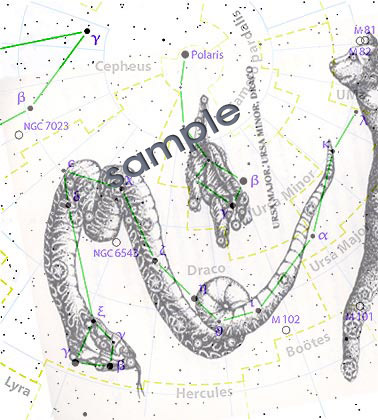
Above, a superimposition (which does not quite align) of the "traditional" representation of Dracon with the modern star-chart (taken from Wikipedia).
The image on the right shows Kadmos (Cadmus) killing the Drakon. The Drakon is coiled around a pillar of the "well-house". This represents at once the pillar of the world tree around which a snake coils, and the idea that the void was a sacred spring.
It is this sacred spring to which Odin sacrificed one of his eyes to gain wisdom, and the same well described by Snorri (Prose Edda) as the third root of the world tree in heaven where lies the well in which the gods preside over the world. Staying with Norse mythology, it is the reason why, when Sigurd (the "dragon slayer") , kills the serpent Fafnir, & licks the blood from his finger, he gains wisdom: it is a metaphor for the dragon, Drakon, who guards the spring of wisdom. The pedigree of this idea is traceable at least as far back as the Vinca bowls.
|
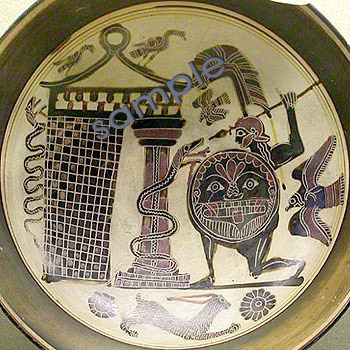
"KADMOS & THE DRAKON
Museum Collection: Musée du Louvre, Paris, France
Catalogue No.: Louvre Ca1860
Beazley Archive No.: N/A
Ware: Laconian B lack Figure
Shape: Kylix
Painter: Attributed to the Horsemen Painter
Date: ca 550 - 540 BC
Period: Archaic
SUMMARY
Kadmos battles the guardian serpent of the sacred spring of Ismene. The beast strikes out from its place coiled around the pillar of the well-house."
Image source, and quote source: http://www.theoi.com/Gallery/K28.3.html
|
Not only does Drakon circle around the void, the "chasmos" (chasm = where all is lost), but this constellation was created to indicate the celestial path at which the moon and sun intersect (according to the Wikipedia, that it does so intersect at these points is an "accident"). Additionally, in the myth of Kadmos, as recounted by Apollodorus (Library 3.4.1), a dragon guarded the sacred spring of Ares at Thebes, and it is obvious that the sacred spring is the void around which the serpent circled, the very spring to which Odin in Norse mythology sacrificed one eye to drink from and so acquire wisdom... That is, the void is the "well" in the heavens. (Ares also had a sacred oak somewhere in the Black sea which was visited by Jason, where another serpent guarded the sacred oak on which was suspended the golden fleece).
It is evident that in the Lagash vase, as well as the Greek Dracon of classical Greek mythology, and the Vinca bowl we are seeing a representation of an identical phenomenon: the rotational axis of the earth, the polar axis. Whereas the motif for Drakon finds precedent in the culture of northern Greece, how did it come to appear in the near east? It is not indigenous to the near east.
Mesopotamian representations of the cosmos, which precede the Lagash vase, show (to use only one example) the polar axis presided over by acolytes, pouring from their vases the "waters from the abyss" (as there was no polar star, but a number of "circum-polar" stars which circled the chasm). There are no serpents. The abyss is the source of cosmos... the great hole in the sky... the polar axis.
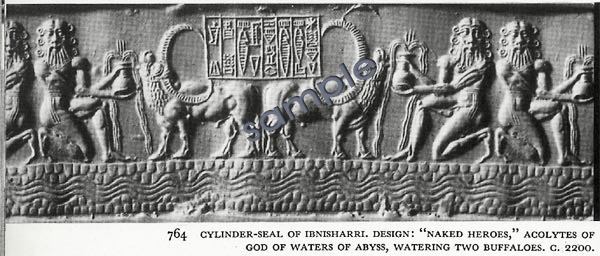
"God of waters of the abyss, c.2200"
Image source:Illus. 764 The Art of the Ancient Near East
by Pierre Amiet, Naomi Noble Richard
ISBN: 0810906384
(Amazon link).
|
OBJECTION 3- The horned serpent. The horns symbolising the moon and representing lordship over the heavens, had its precedent 3 thousand years before its Near East appearance in the southern Balkans (Macedonia):
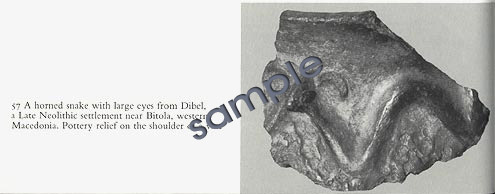
|
A horned snake from a Late Neolithic settlement in Western Macedonia p.95 The Goddesses and Gods of Old Europe : Myths and Cult Images
By: Marija Gimbutas.
The horned serpent of the Neolithic Balkans, appears 3,000 years before the Lagash vase; and 4,000 years before the horned serpent god Marduk.
|
It is self-evident that the snake-cults were European, and that the snake-cult radiated from its European source... entering the Near-East from somewhere between the Black and Caspian seas. It is significant that according to Greek tradition concerning Jason and the Argonauts, that the serpent-controlling Medea was from from the Black Sea coast, at the foothills of the Caucus mountains. This mountainous terrain extended southward to the Taurus mountains, to the Amanus forests of northern Syria and the Zagros mountains north of Elam which formed part of the continuous mountain ring that hemmed in the mesopotamian plains.
OBJECTION 4- It is to the north and east of Mesopotamia, in the surrounding Zagros mountains where there were cultures who did worship the snake (though there is no evidence of snake worship before the fourth millennium BC) are to be found. It is Elam (in modern Iran) that stands out. For the Elamites/proto-Elamites (neighbours of the Guti) the snake was the fabric of the cosmos.
During the Sumerian "renaissance" at Lagash, the ruler Gudea:
"boasts on one of his statues that he conquered 'with weapons the town of Anshan in Elam', and asserts on a cylinder: 'Elamites came from Elam, Susians from Susa [Susa the capital of Elam]' - that is came to help him in the reconstruction of the temple. On this evidence it would seem that Elam lay under the influence of the south-Mesopotamian princes of Lagash while the Gutians were supreme in northern Babylonia." p.81 Hinz, The Lost World of Elam.
The Lagash vase, it becomes obvious, is tribute to the rulers of Lagash from a foreign source.

Image source: Plate 20. The lost world of Elam, re-creation of a vanished civilization
by Walther Hinz ISBN: 0283978635
(Amazon link)
Snake vase, dated to "Susa B" c.3900 BC
|
Footnote: Dating the eastern Serpent.
Walther Hinz, plate 22 (below) reproduces a bitumen relief showing 2 naked priests with an intertwined "sky-snake" which Hinz dates to "Susa B".
Plate 20, of Hinz's book reproduces a vase (left) depicting a snake, which is dated by Hinz to "Susa A".
This snake is reproduced in Potts', fig. 3.3, p.49 and is referred to as an example of "Susa 1 pottery". Susa 1 dates are from around 4300-3500 BC. (Note: the actual dates given by Potts are from 4395-3955 BC to 3680-3490 BC. p.49). Hinz dates the serpent vase to the 4th millennium BC.
On Balance:
This means that:
the "snake vase" (left) dates to c.3900BC;
the priests (below) date to c.3400-2800 BC.
|
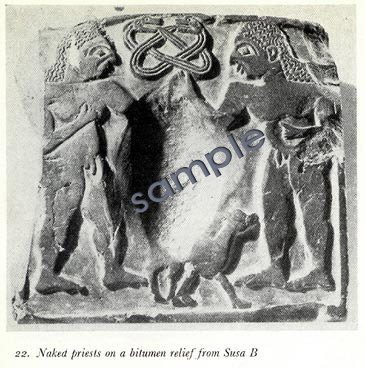
Image source: Plate 22. The lost world of Elam, re-creation of a vanished civilization
by Walther Hinz ISBN: 0283978635
(Amazon link)
Two naked priests are depicted (above). In the centre of the relief above the priests is depicted an intertwined double-headed serpent. It dates to "Susa B", and is tentatively dated to approximately 3400-2800BC
|
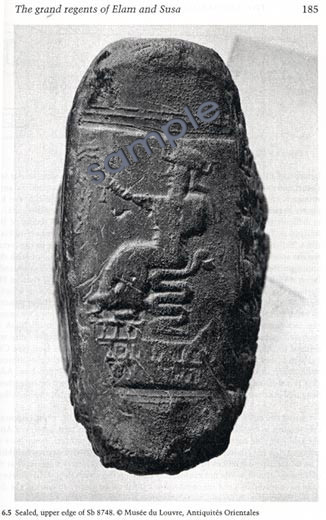
Image source: Plate 6.5, p.185. The Archaeology of Elam: Formation and Transformation of an Ancient Iranian State (Cambridge World Archaeology)
by D. T. Potts ISBN: 0521564964
(Amazon link)
Serpent Thrones proliferate in Elam (modern Iran) during the sukkalmah period, which dates to c. 1930-1600 BC (Potts p.182). Note: The earliest representation of the snake thrones predate by up to 150 years the first epics of Gilgamesh.
|
As Hinz comments:
"the snake is... a true leitmotif of Elamite civilization. Even pottery of the third and fourth millennia swarm s with snakes (Plate 20). They appear on jar-stoppers and on the lids of vessels as symbols of protection against evil. Snakes rear up as guardians of the gates, crawl over carvings of kings, twine around altar plates ... Coiled up, they serve as a seat for the god..." Hinz p.41
The Sumerian version of Gilgamesh makes it incontrovertibly clear that the snake was evil, an affliction. It was foreign to mesopotamia. To elucidate its meaning one has to look at sources outside mesopotamia.
Marduk & Timat ( a brief introduction)
Among claims made of the antiquity of the Near-East serpent is that the snake Timat is is killed by Marduk and and carved up to create the sky and the earth in Mesopotamian literature. Again, as has become a customary mantra the reasoning proferred for the antiquity of this story follows the same pattern used in the Gilgamesh tale: mesopotamian civilization began at approximately 3,500 BC, thus even a tale that first appears 2,500 years later at c.1150 BC is assumed to be as old as mesopotamian civilization itself.
What is of significance is a general supposition that Marduk was the Babylonian god always worshipped in Babylon. However, Marduk makes his initial appearance in the Epic of Creation. The "tablets on which the work was written date mainly to the first millennium... Although plenty of literary texts of the early second millennium have been found, none of them contains the Epic of Creation, but this of course, is an argument of silence." Dalley p.228, Myths from Mesopotamia OUP. (link:http://www.amazon.com/gp/product/0192835890 ) Dalley instead prefers to place him to c.1200-1150 BC, even though the written records only support a date of around 900 to c. 700 BC. There is some merit to Dalley's proposition, as a horned serpent god, who could be assumed to be Marduk is portrayed as a chthonic serpent god. (Marduk's symbol is a spade symbolising his chthonic nature; as Marduk is represented as a horned serpent his domain is the underworld from where he rules the heavens). The Epic of Creation according to Dalley's wishful dating places Marduk at the end of the Kassite period. The supposition that the Epic of Creation is "Babylonian" rather than Kassite does not make sense in any archaeological context. [end of on-line commentary]:
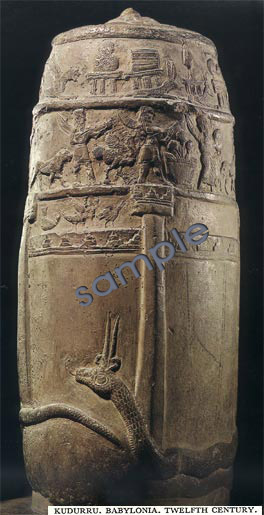
|
Image source: illus. 515 The Art of the Ancient Near East
by Pierre Amiet
[end of on-line commentary]
|
Marduk's reign however was short-lived. Though it is claimed that the Assyrians and Babylonians shared a common Semitic civilization, the rise of the neo-Assyrian empire brought with it different values to those of the Babyonians and Marduk was deposed. It begs the question of why one group of "Akkadian-speaking" Semites (the people of the city of Babylon) worshiped gods of the underworld, while another group (the people of the near-by city of Ashur), speaking the same language did not. It would seem that Marduk was never a Semitic entity, but a reflection of the cosmology of the foreign rulers of Babylon, the Kassites, during whose occupation it seems the cult of Marduk became widespread. There is much to merit the attribution of The Epic of Creation to the Kassites and not to the Babylonians. In Kassite "kudurru" (boundary stones) the horned serpent is always at the base - and in some instances it is accompanied by the scorpion, which, one suspects represents the scorpion men who guard the "crossing" from this world to the heavens and the underworld, the crossing of the gods from the heavens to the underworld (and prevent the dead from ascending back into the world of the living) in The Epic of Creation.
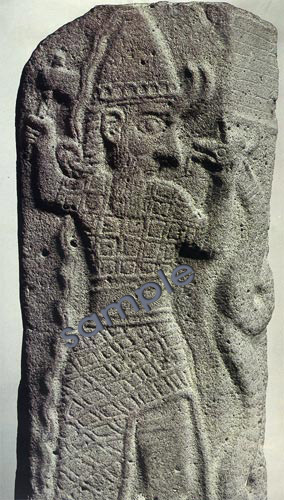
|
In this stele, dedicated by an Assyrian king is depicted a horned god smiting the horned serpent Marduk. What is of significance is that this god wields a European battle-axe... so, what is the European connection?
[THE BATTLE-AXE & TRIDENT]
Image source: illus 102 The Art of the Ancient Near East
by Pierre Amiet
[end of on-line commentary]
|
|
|
The Drakon and the zodiac
Image source: p. 153 Astrology: a history
by Peter Whitfield. isbn:0810942356.
According to Whitfield, the head and tail of Drakon acquired the status of planets in Classical astrology. "These points were in fact the lunar nodes, the 2 places where the moon's path crossed the ecliptic each month... The dial gives the position of the nodes through the year." (p.153).
British Library, C.7.c15.
... This is the same "Drakon-cum-Hydra" that was first represented in the Balkans 7000 years earlier. There is a claim that the zodiac was an idea that originated in Babylon. However, this is highly unlikely.
|
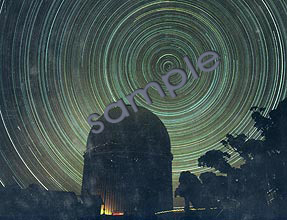
Time-lapse photograph of the night sky showing the "rotation of the heavens".
Images source, back-cover dust-acket of THE CAMBRIDGE ATLAS OF ASTRONOMY, Introduction by Bernard Lovell. Isbn: 0521263697
|
© The images on this page are © of the various publications. They have been presented on this page on the understanding of "fair use".
This is the internet version of an essay which forms part of a series which investigates "the world tree and the sacred grove", "the spread of the trident and battle-axe" and "origins of the spiral" (among other themes). They are all related. I have no intention (at this stage) of posting this additional research online.
© demetrios vakras

|
|
